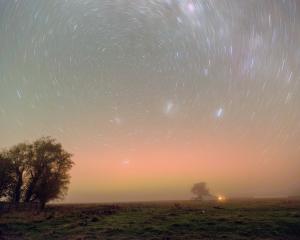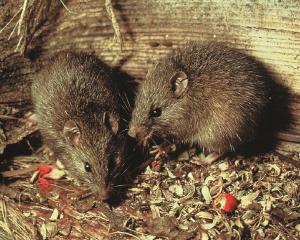The isolated Nevis Valley, once home to moa hunters and miners alike, offers a unique glimpse into the past, writes Shane Gilchrist.
Those cavalcade participants who endured a rain-enforced extra few hours in the Nevis Valley last week might like to spare a thought for Frances (Fanny) Graham.
Summoned from her home in Ireland by husband Andrew, who had headed to the Nevis in the mid-1860s to continue his search for gold, Fanny sailed for Dunedin in the late 1860s before she and her three children were met at Clyde by Andrew; together the family walked the rest of the way to the Nevis.
On their eventual arrival in the valley, Fanny discovered Andrew had made the family a home - beneath a rock shelf.
"He built a corrugated iron front with a door and a window. That was it," explains Lex McLean, great-grandson of the couple, who lives in Earnscleugh, Central Otago.
Having arrived from the Australian goldfields, Andrew departed the Nevis in 1876, leaving behind his pregnant wife and five children. At that stage, the family was still living under the rock.
"Just after he left a downpour loosened the rock roof and the family had to leave, finding accommodation at the Upper Nevis, at the southern end of the valley, in two little stone huts," Mr McLean says.
"The eldest boy, Sam, was about 11 or 12 and out working.
"She would sew canvas hoses and things. They survived. Sam and then his brother Andy, worked on mines and got enough money together to build a house.
"Andrew, the father, went back to Australia and tried to come back about five years later. But the two sons met him at the top of the Carrick Range and gently told him that their mother had been through enough. So the father turned his horse around - or had it turned around for him - and was never heard of again."
The fourth generation of his family to have searched for gold in the Nevis, Mr McLean knows of similar tales, of fortunes made and lost, and of relationships that cooled as markedly as the winter's air in that valley.
Sealed off from its (comparatively) more populous surroundings by the Carrick, Remarkables and Hector mountain ranges and a southern gorge virtually impassable in the coldest months, the Nevis offers a clear window on our past, both recent and pre-European.
Much of that history will be celebrated next weekend at the Nevis Gold 150 celebrations.
Held in the Lower Nevis Valley, the event will include displays focusing on the history of gold-mining, the families of the area, artefacts, blacksmith demonstrations and even a replica of the old post office.
As co-ordinator of the celebration, Mr McLean has been busy (as have others) collating information, delving through boxes of photographs and family histories. In fact, he's been too busy recently to manage the hour-long drive from his Earnscleugh home up over the 1300m Duffers Saddle on the Carrick Range, a route that, after many twists and turns, offers a spectacular view of the Nevis.
"The Nevis does mean a lot to me," says the retired teacher, who will celebrate his 72nd birthday next weekend.
"My grandfather, John McLean, was a miner, too. He married Frances, or Fanny, who was named after her mother.
"My father, Ian, was born in the Nevis. My mother, Gavine, went there in 1927 as a schoolteacher. For a time they lived in Milton and that's where their four children were born.
"But we went back to the Nevis in 1948. My parents basically stayed until they were in their early 90s, up until about 1990. They would get out in winter."
Mr McLean recalls an uncomplicated childhood.
"We were just like other country kids. We had the whole valley to ourselves. As kids, we would mine for gold.
"The Nevis Hotel closed in 1952 and that signalled a great exodus from the valley. The school closed, too, that year. There was a hall and a library, too. But that has all gone.
"I left the Nevis to do my last year of high school at South Otago in 1957, then I went to university so I was out of the scene for the next few years.
"When I finished university I went back to help dad with an underground gold mine and I did that for the next four years before I went teaching."
Mr McLean believes only about 10% of the gold has been taken from the Nevis. However, what remains isn't easily accessible.
"The Nevis is one of those places that's away from everything else. It's isolated and difficult to get to. Through winter, they would stop mining. Those people who could went out of the valley.
"Some people only lasted there a few hours. However, others stayed. One guy who arrived in 1863 left when he was an old man around 1910-1915; he lived in his hut the whole time and didn't go out in the winter.
"He didn't get much gold but got enough to survive."
Following the pattern of other areas, population peaked at the start of the Nevis gold rush.
After discovering gold at Nokomai, near the southern end of Lake Wakatipu, miners headed to the Dunstan via the Nevis Valley, where they found gold in its headwaters in October 1862.
By November 1862 newspapers were reporting a rush at the head of the valley, the middle gorge and the lower valley.
The first Nevis Township, on the eastern bank of Commissioner's Creek, provided services for some 1500 miners. In 1862 60 businesses lined its main street.
"A lot of those people were very mobile," Mr McLean says.
"If they were in camp and someone read about a gold strike elsewhere - say, Skipper's or somewhere - two-thirds would be gone the next day. You don't get rich by being the thousandth person to arrive somewhere. The earlier you got there to secure a good spot, the better your chances."
Other places in Otago (Lawrence, Queenstown, Arrowtown, Clyde, Bannockburn, Naseby and St Bathans) also owe a debt to gold.
Horatio Hartley and Christopher Reilly's 1862 find sparked the rush to Dunstan (the areas around Clyde, Alexandra and Cromwell) with diggers working the Clutha, Kawarau and Shotover rivers as well as their tributaries.
At the peak of the rush in 1863 the various goldfields populations were estimated at more than 23,000, of whom some went on to find other uses (farming, orcharding) for the land they had worked or discovered.
Though the Nevis may have had fewer prospectors than elsewhere (a few months after Gabriel Read's discovery of gold in May 1861 in a gully near Lawrence that now bears his name, the once quiet area hosted nearly 11,500 fortune-seekers, more than twice the population of Dunedin at the time), it remains an important record of events.
Matthew Schmidt, New Zealand Historic Places Trust regional archaeologist (Otago-Southland), describes the Nevis as the last unmodified valley system in which an unbroken sequence of gold-mining, from the 1860s up to the 1940s, can be seen.
"The unique thing about it is you have all the types of mining systems represented.
"There are the diggings by the early miners, who did trenches and pits; then there is the ground sluicing near rivers such as Schoolhouse Creek and elsewhere; later came larger hydraulic elevating, which is where they put big pipes down pits; then the dredge boom of the 1890s to about 1939.
"There are also the related systems and supply lines to the mining. The road through there is the original one; the coalmines supplied the dredges with coal; there are the hotel ruins; there are stonewall and sod-wall ruins.
Both the Upper and Lower Nevis have all these sequences of events.
"There was also a massive population of Chinese there. At one time, there were about 600 Chinese in the valley; you can see their mining claims as you come down into the valley from the Carrick Range."
The pastoral history of the Nevis is important, too, Dr Schmidt says.
"It was there before the miners arrived and is there now. You can see the old homesteads; you've got the Ben Nevis group of buildings and the Craig Roy buildings. As the miners left, the farmers continued.
"The Maori were there as well. A massive moa-hunting site was recorded by an amateur archaeologist in 1917-1918. It appears a dredge might have destroyed most of it. When he was there, some of the dredge hands had adzes and things."
According to New Zealand Historic Places Trust records, occupation sites show that Maori butchered moa in the vicinity of Schoolhouse Creek, with remains of a campsite and moa-butchering site nearby dating from about the 14th century.
Evidence suggests as many as 2000 moa may have been butchered there.
"There are dozens of archaeological sites recorded in the valley. But the valley has never been systematically recorded, so there's likely a lot more there," Dr Schmidt says.
"It's a beautiful valley. It is such an amazing place."
Prized history
The historical and heritage value of the Lower Nevis Valley was formally recognised by the New Zealand Historic Places Trust in 2010, when it registered the Lower Nevis Historic Area.
The registration identified the historic values associated with the Lower Nevis, 32km from Cromwell, so they could be discussed in any future plans for the valley.
Registration is an advocacy tool intended to identify and inform people about New Zealand's historic heritage. There are no short or long-term legal obligations on property-owners that directly arise from registration.
The celebrations
The Nevis Gold 150 celebrations, to be held in the Nevis Valley from March 9-March 11, include displays focusing on the history of gold-mining, Nevis families and artefacts, blacksmith demonstrations and a replica of the old post office. On March 11, a 4WD tour will travel over the pylon road from Clyde before visiting various goldmining sites in the Nevis.
For more information, visit: www.gold150.org.nz













